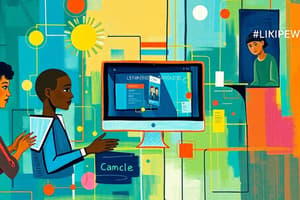Podcast
Questions and Answers
Which of the following represents a key component of digital literacy?
Which of the following represents a key component of digital literacy?
- Managing one's digital footprint.
- Analyzing information for informed decision-making. (correct)
- Respectful communication online.
- Protecting personal information.
What is the primary purpose of empowerment technology?
What is the primary purpose of empowerment technology?
- To regulate online behavior.
- To promote social media engagement.
- To eliminate the need for traditional education.
- To enhance personal and professional growth. (correct)
Why is digital footprint management crucial?
Why is digital footprint management crucial?
- It simplifies social media account management.
- It allows one to keep secrets online.
- It significantly impacts one's personal and professional reputation. (correct)
- It helps in making personal connections more effective.
What is a common challenge associated with empowerment technology?
What is a common challenge associated with empowerment technology?
Which tool is NOT classified as a collaboration tool?
Which tool is NOT classified as a collaboration tool?
Flashcards are hidden until you start studying
Study Notes
Lesson 1: Introduction to Empowerment Technology
- Definition: Empowerment technology refers to tools and resources that enable individuals to create, share, and manage information effectively.
- Importance:
- Enhances personal and professional growth.
- Facilitates collaboration and communication.
- Supports lifelong learning and skill development.
- Key Components:
- Digital literacy: Understanding and utilizing technology.
- Information management: Organizing and evaluating data effectively.
- Critical thinking: Analyzing information for informed decision-making.
Lesson 2: Digital Citizenship
- Definition: Digital citizenship encompasses responsible and ethical use of technology.
- Key Aspects:
- Etiquette: Respectful communication online.
- Safety: Protecting personal information and privacy.
- Responsibility: Acknowledging the impact of actions in a digital environment.
- Digital Footprint: The trail of data one leaves online; important to manage it wisely.
- Cyberbullying: Understanding, prevention, and intervention strategies.
Lesson 3: Tools for Empowerment
- Types of Tools:
- Communication Tools: Email, messaging apps, video conferencing platforms.
- Collaboration Tools: Cloud storage (Google Drive, Dropbox), project management software (Trello, Asana).
- Content Creation Tools: Blogs, social media platforms, video editing software.
- Benefits of Using Technology:
- Increased accessibility to information and resources.
- Enhanced productivity and efficiency in tasks.
- Opportunities for networking and community building.
- Challenges:
- Digital divide: Inequality in access to technology.
- Over-reliance on technology: Balancing tech use with traditional methods.
Lesson 1: Introduction to Empowerment Technology
- Empowerment technology enables users to effectively create, share, and manage information.
- Facilitates both personal and professional development, leading to increased opportunities.
- Promotes collaboration and enhances communication in various settings.
- Encourages lifelong learning and continuous skill enhancement.
- Digital literacy is essential for understanding and utilizing technology effectively.
- Information management involves organizing and evaluating data for practical use.
- Critical thinking is necessary for analyzing information to make informed decisions.
Lesson 2: Digital Citizenship
- Digital citizenship refers to the responsible and ethical engagement with technology.
- Online etiquette promotes respectful and appropriate communication in digital environments.
- Safety involves the protection of personal information and maintaining privacy online.
- Responsibility includes recognizing the consequences of one’s actions in the digital realm.
- A digital footprint is the aggregate of data left by individuals online; managing it is crucial for personal branding and privacy.
- Cyberbullying awareness includes understanding its impact, prevention strategies, and appropriate intervention methods.
Lesson 3: Tools for Empowerment
- Communication tools include email, various messaging apps, and video conferencing platforms that facilitate real-time engagement.
- Collaboration tools such as cloud storage (e.g., Google Drive, Dropbox) and project management software (e.g., Trello, Asana) enhance teamwork.
- Content creation tools encompass blogs, social media platforms, and video editing software, allowing users to express ideas creatively.
- Utilizing technology leads to increased accessibility to information and diverse resources.
- Technology enhances productivity and efficiency across various tasks.
- Technology facilitates networking and community engagement, allowing users to connect with like-minded individuals.
- Challenges include the digital divide, which highlights inequalities in technology access among different demographics.
- Over-reliance on technology can lead to the neglect of traditional methods; balance is necessary for optimal outcomes.
Studying That Suits You
Use AI to generate personalized quizzes and flashcards to suit your learning preferences.



